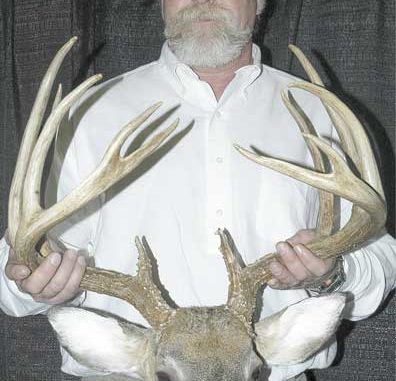
Fate helped two hunters bag N.C.’s best 2007 muzzle-loader bucks.
Journalists and novelists often write about Fate.
For North Carolina trophy whitetail hunters, “Fate” means the first and second weeks of November and is spelled “r-u-t.”
That’s what Charles “Drew” Strader and Nathan “Chris” Lyerly discovered last year — with some good luck.
The two men, hunting during the first week of the central-region deer season, each bagged a buck that won muzzle-loader categories at the March 2008 Dixie Deer Classic in Raleigh.
Roxboro native Strader, who had almost no time to hunt because of his job, used a borrowed smoke pole and walked Nov. 3 to a stand a quarter-mile from his house while Lyerly, who lives in highly-populated Mooresville, drove two hours Nov. 7 to Anson County where he’d pursued deer the preceding four years with moderate success.
***
The 24-year-old Strader, a mechanic at Progress Energy’s Hyco Lake power plant, probably wouldn’t have had a chance at his buck if he’d hunted any other time of the year.
“I hunted two days during bow season and one day during muzzle-loader season last year,” he said, “because we had a major turbine outtage that lasted 40 days. We worked on (the turbine) right through (deer) season.
“This (muzzleloader) buck was the only deer I killed.”
However, the 24-year-old said he wasn’t entirely lucky but used lessons he’d learned while botching several chances at bucks.
“I’ve been a deer hunter since I was 12 or 13, but I really didn’t know how to do it right,” he said.
But Strader said he’d learned valuable lessons from “several years of seeing nothing and talking to a bunch of people. I’d been (hunting) in the wrong spots and doing the wrong things — making a lot of noise, going in (to his stand) the same route, same time every day. I also learned you shouldn’t scout a lot in an area you want to hunt.”
During August 2007 he received permission to hunt private land near his home.
“I also practiced (with a bow) a lot more, something I shoulda been doing before,” he said. “But when I hunt with some buddies, we pass up shots because we learned we couldn’t just shoot anything. We wanted to manage (the land) for quality bucks.”
During a Sunday scouting trip, his only off-work day during the outtage, Strader found a spot he wanted to hunt near a bedding area. It was filled with signs of a big buck.
“I saw some fresh rubs, three within 30 yards of each other,” he said. “One was a sapling cedar that had been destroyed all the way to the ground, with ‘strings’ (of cedar bark) at the bottom; a couple stretched out a foot or two from the tree.
“You could tell a good buck had done that.”
While he was squatting down at the cedar tree, examining the buck’s work, Strader’s first stroke of good luck occurred as a “nanny” doe walked past about 35 yards from him.
“It was so thick, she couldn’t see me,” he said. “She was going ‘naaa-naaa,’ so I figured she was in heat, and that meant a buck would be around. I decided that’s where I was gonna put my stand.”
Strader’s second stroke of serendipity occurred the next day when a fellow worker at Hyco Lake said a contractor wanted to work the next Sunday instead of Saturday, opening day of muzzle-loader season.
“The other guy said he’d swap with me and let me be off Saturday and I could work for him Sunday,” Strader said. “I was tickled to death.”
When Nov. 3 arrived, Strader left his house at 5 a.m., carrying an old climbing stand; an 50-caliber iron-sight Knight muzzle-loader rifle he’d borrowed from his father-in-law, Marty Perkins; and a backpack.
“I was determined I was gonna stay up there (in the stand) all day if I had to,” said Strader, who was wearing Carhartt camouflage bib overalls, a fleece camouflage shirt and a Mossy Oak knit cap.
“I didn’t put out any (deer) scent,” he said.
Strader didn’t have to sit for long in his oak tree stand about 22 feet off the ground. He had an open field of vision for 70 yards around the oak copse.
“I had a thick cutover in front of me (deer) bed in,” Strader said. “That’s where the nanny doe had been heading. At 8 a.m. here comes the buck out of the oaks, also headed for the cutover. He was picking his way along, eating acorns.”
Strader said during 2006 he’d taken a too-quick shot and lost a wounded buck, so he made up his mind to wait for a prime moment before he pulled the trigger. His patience was rewarded as the deer meandered away from him, then turned toward his stand.
“He was 20 yards from me when I pulled the trigger; he was broadside to me,” Strader said.
Hit behind the right shoulder, the deer fell in its tracks.
“The shot jellied him,” Strader said.
Taxidermist Randy Dunkley counted 21 scoreable points on the buck’s rack that Dixie Deer Classic totaled at 154 3/8 non-typical points.
The buck weighed 185 pounds.
***
Lyerly, a self-employed cabinet builder and real-estate manager, also had a little bit of luck when a friend got him a membership in an Anson County deer club five years ago.
That region — part of the Pee Dee River drainage with the Pee Dee National Wildlife Refuge at its northeastern corner — has been a trophy buck producer for decades. Five of N.C.’s top-100 typicals have come from Anson, plus the No. 3 non-typical, Keith Reese’s 204 7/8 muzzle-loader giant.
So it was no surprise Lyerly had the only Tar Heel Boone&Crockett qualifier at the Classic last March.
His 12-pointer boasted 170 0/8 inches of antler and ranks 15th among Tar Heel B&C typicals.
“The club had killed some good bucks, but nothing like that one,” said the 56-year-old Lyerly.
“I’ve been a muzzle-loader hunter for about 15 years,” he said. “Right now I’m using a CVA Optima Pro .45-caliber in-line gun. It shoots a Powerbilt bullet and I used 150 grains (three pellets) of powder.”
Lyerly was in the woods by 5:45 a.m., in a Loc-On stand a few hundred yards from where he’d killed a small buck during October’s bow season. His stand was at the edge of a cutover adjoining a re-planted forest containing small pines.
“It was a cool day, a little foggy with the temperature in the 40s,” Lyerly said.
He could hear deer near his stand when he climbed into the Loc-On that morning, but he couldn’t see them in the darkness.
“At daybreak, about 6:45 a.m., (the buck) came walking out with his nose to the ground,” Lyerly said. “I assumed he was trailing some does in that earlier group. He came out of the planted pines, walking toward the clear cut.”
With the deer 70 yards from him, Lyerly put the crosshairs of the Nikon scope on the buck’s right shoulder.
“I had to holler five or six times to get him to stop walking,” the hunter said.
When Lyerly pulled trigger, a cloud of thick smoke obscured the buck.
“I wasn’t a bit nervous leading up to the shot,” he said. “After (the shot) I thought the deer had run over a small hill and out of my sight. I remember thinking ‘I guess I ought to re-load’ and that’s when it hit me; I had trouble re-loading. Then I said I guess I should wait. That’s when I said, ‘Heck, that’s long enough,’ so I got down.”
Lyerly was sure of the buck’s direction after the shot.
“He’d run about 20 yards and turned a flip and that’s where I found him,” he said. “I dropped down on my knees; I was overwhelmed.”
After gutting the deer, Lyerly walked to his ATV, drove it to the buck, loaded the deer and returned to camp.
“It was so early I was there all by myself and had to wait hours for the other guys to come back,” he said.
When his friends returned, Lyerly said, “They went crazy.” The club had killed some nice bucks but none to match this one. No one had seen any sign of this deer, but it’s so thick you don’t see that many deer; there’s so many places (for whitetails) to hide.”
Lyerly said he’d chosen a particular area because he’d seen signs of another big buck.
“This buck’s (antler) tips nearly touched (3 3/8 inches between them), so he couldn’t get (his antlers) around a tree to make rubs,” he said. “But I’d seen probably his tine marks on a big cedar right in front of my stand. A buck had tore up a small bush.”
The 5×5’s main frame had a right beam of 26 inches and a left beam of 27 1/8 inches. The G1s were 3 1/8 and 3 1/8 inches with the G2s measuring 11 3/8 and 10 3/8 inches, while the G3s were 12 6/8 and 11 3/8 inches. The G4s were 8 6/8 and 9 1/8 while the G5s were 4 4/8 and 3 4/8 inches.
Circumferences of the main beams were 4 2/8 and 4 4/8, 3 7/8 and 3 7/8, 3 5/8 and 3 5/8 and 3 3/8 and 3 4/8 inches. The inside spread was 17 inches with a 19 4/8-inch widest spread. The two abnormal points of 2 2/8 and 1 2/8 inches left a gross score of 178 7/8 inches.

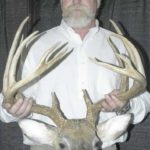
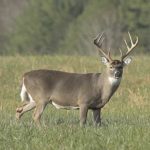
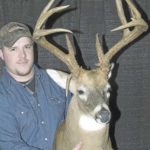
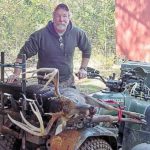
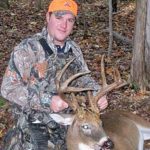



Be the first to comment